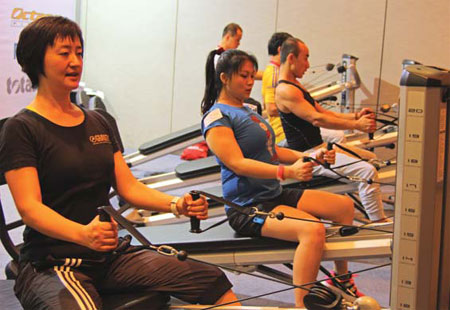Down at the gyms
Updated: 2012-10-26 09:56
By Xiao Xiangyi (China Daily)
|
||||||||
|
A coach gives an exercise tip to a visitor at the China Fitness Summit in Beijing. Provided to China Daily |
China's fitness industry lacks muscle and suffers from growing pains
The American economist Paul Zane Pilzer predicted in his 2002 bestseller The Wellness Resolution that preventative medicine and fitness would be the next trillion-dollar industry. This should have been particularly true in China, where there is an expanding mass of people with the time and money to feed their desire to keep fit and healthy.
But there has been no easy money in China's fitness industry, judging by the performances so far of both international and homegrown fitness centers.
Surprisingly, brands with foreign investment hit the wall first. The joint venture of the former US fitness giant Bally Total Fitness and China Sports Industry Group, formed in 2001, has reduced the number of its gyms from 44 at its peak in 2008 to less than 30 today.
Others have changed ownership. California Fitness Clubs, which used to be under the umbrella of the US- based 24 Hour Fitness, were sold to the Ansa Group in August, making it a local brand.
"The international clubs that have a difficult time in China are franchises, and they just have one concept for their gyms in different countries and cultures," says Theo Hendriks, CEO of Sports and Leisure Group, a leading fitness company in the Netherlands.
Hendriks once declined to become a partner of 24 Hours due to its inflexibility.
"In Holland, we look at our wallets carefully," he says. "If we do not use the swimming pool, we want a discount. But the big firm says no, take it or leave it."
Walter Macdonald, founder of the wellness management company WM Consultants, who has been in the industry in China for 17 years, believes most international fitness firms do not understand the Chinese market.
"All the ideas that work in the West mostly don't work here," he says. "Fitness is not like fast food chains that can easily change the menu according to local taste."
But no one doubts the immense market potential in China. The penetration rate of fitness facility members in the US is 16 percent. It's 15 percent in Netherlands and 13 in the UK. In the Chinese mainland, it's only 0.3 percent, according to Hendriks.
In market size, $31 billion (23.8 billion euros) a year is spent on fitness in Europe, he says. In the US, it is $25 billion, but only $11 billion in Asia.
"The penetration rate in China will at least rise to 3 percent in 10 years," Hendriks claims. "Which means there will be 16,000 clubs in the Chinese mainland and about 40 million people going to gyms."
Twenty years after modern fitness centers appeared in China, the market is still in its infancy and going through a reshuffle.
"China's young fitness industry has already felt the growing pains," says Yan Sihai, founder and general manager of ChinaFit, a professional web portal for the fitness industry.
Going to gyms and fitness classes in China is not yet a widely accepted lifestyle, more an "impulse consumption behavior", says Zhang Qing, founder of KEY-solution, one of the oldest sports consulting companies in China.
Zhang says fitness is largely seen as an individual activity involving body and exercise equipment.
"It's hard to endure for Chinese people who love social life so much and overlook individualism," he says.
"The competitors to fitness centers in China are actually cinemas, KTVs (karaoke clubs), shopping malls and bars. We are asking people to give up their spare time and do something," says Macdonald.
In an attempt to compete against rivals within and outside the sector, fitness centers are cutting prices for memberships, training classes and other services.
"Simply lowering the price without improving the service is never a solution, especially when labor and rent costs are soaring and the margin is as thin as the blade," says Zhang, who believes that the core competitiveness should lie in good service.
Another fly in the ointment is consumers' distrust in clubs. Many clients fear clubs they have joined - one year is the usual membership term in China - may close suddenly and they will not receive a refund.
On the other side, investors and operators worry about retention rates.
"The average retention rate for Chinese fitness clubs is around 20 percent, which means 80 percent of time they have to find new clients to fill in the blanks," says Liu Xu, founder of Possibility Consults, a wellness consulting company based in Beijing.
Hosa Fitness Clubs, one of the biggest fitness chains in China, has more than 500,000 members. Currently its retention rate is about 50 percent.
Wu Chenghan, director of operations at Hosa, says his aim is to increase that to 70 percent within two years. He also announced a rash of new gyms, from the current 82 to 300 by the end of 2013.
Wu says Hosa is changing annual memberships fees to monthly ones to better suit customers' schedules. A pilot scheme is up and running in Xiamen, in southeast China's Fujian province, in cooperation with Bank of China.
"Many people in Xiamen are doing business and travel a lot," says Wu. "They love monthly membership because they don't have to pay when they are away on business for some time."
He says Hosa hopes to roll out the new payment program in all its gyms within a year. "It also helps to build the trust of your members because they feel the banks' support is more reliable," Wu adds.
Though domestic fitness companies account for more than 90 percent of the market share, international investors have not ceased trying to tap the Chinese market. Many are waiting to seize the right time and with the right new product.
It is the third time Hendriks has been to China for the fitness industry summit held by China Fit, but he's also on the lookout for business opportunities.
He has been thinking of bringing a new concept to China - to cooperate with real estate developers and establish a community for Chinese senior citizens.
He wants to combine nice apartments with facilities where elderly people can take part in yoga, tai chi, swimming and other fitness activities.
"Elderly people who do not have much money can rent the apartment and become a member at a low price, and the people who are rich can buy a beautiful apartment and get fitness and social settings for free," says Hendriks.
"It has been realized in Holland. I know one or two investors from Holland are talking to Chinese officials and developers.
"China also has a serious problem with the growing number of elderly people, and this can be a good little pill for that growing pain. It's not easy to succeed here, so all we have to do is to find a win-win solution for this market."
Chinese fitness brands are also vying to establish a distinctive niche with more new concepts and products in order to survive in a homogenized market.
Liu at Possibility says one of his most successful projects is Jianzhihang Fitness in Hefei in East China's Anhui province.
"I knew he thought highly of social networks, so I suggested he open a golf-themed club that replicates the environment and provides golf training facilities," he says.
"A fitness club with a theme targets only a certain group of clients, but very precisely. This also helps avoid investment failure."
Zhang Lu, CEO of Squirrel Fitness Clubs at Baoding, a third-tier city in Hebei province, says her biggest wish is for more support from the government.
For example, clubs with swimming pools have to pay 20 yuan ($3.20; 2.50 euros) for one ton of water, six times more than the ordinary commercial rate because fitness clubs are charged as part of the entertainment industry.
"China pays much more attention to competitive sports than national fitness," she says. "The Olympic Games are the events when the people who need exercise most watch the people who need rest most doing sports." But changes are afoot, and some regional governments are taking action.
The provincial government of Jiangsu, a relatively rich province on the country's east coast, launched a pilot program in Suzhou and Nantong at the beginning of this year, allowing medical insurance cards to be used in local fitness clubs. The state insurance pays a percentage of the membership fee.
"We need support because what we are doing is improving the nation's health," Zhang says.
xiaoxiangyi@chinadaily.com.cn
|
Visitors work out at the China Fitness Summit in Beijing. Some 2,000 instructors and fans participated in the event. Provided to China Daily |
(China Daily 10/26/2012 page10)

 Relief reaches isolated village
Relief reaches isolated village
 Rainfall poses new threats to quake-hit region
Rainfall poses new threats to quake-hit region
 Funerals begin for Boston bombing victims
Funerals begin for Boston bombing victims
 Quake takeaway from China's Air Force
Quake takeaway from China's Air Force
 Obama celebrates young inventors at science fair
Obama celebrates young inventors at science fair
 Earth Day marked around the world
Earth Day marked around the world
 Volunteer team helping students find sense of normalcy
Volunteer team helping students find sense of normalcy
 Ethnic groups quick to join rescue efforts
Ethnic groups quick to join rescue efforts
Most Viewed
Editor's Picks

|

|

|

|

|

|
Today's Top News
Chinese fleet drives out Japan's boats from Diaoyu
Health new priority for quake zone
Inspired by Guan, more Chinese pick up golf
Russia criticizes US reports on human rights
China, ROK criticize visits to shrine
Sino-US shared interests emphasized
China 'aims to share its dream with world'
Chinese president appoints 5 new ambassadors
US Weekly

|

|








